The increased synthesis of erythrocytes in the bone marrow results in an elevated number of reticulocytes (red and purple area) in the peripheral blood. It can be measured in the reticulocyte channel of the haematology analysers SYSMEX XE-5000, XE-2100 and XT-2000i. In this example the measured reticulocyte fraction was 7.9% (upper limit of the reference range: 2.1%). A better indicator of the increased erythropoiesis is the reticulocyte production index (RPI) which additionally considers haematocrit and reticulocyte maturation time.

|
|
|
|





